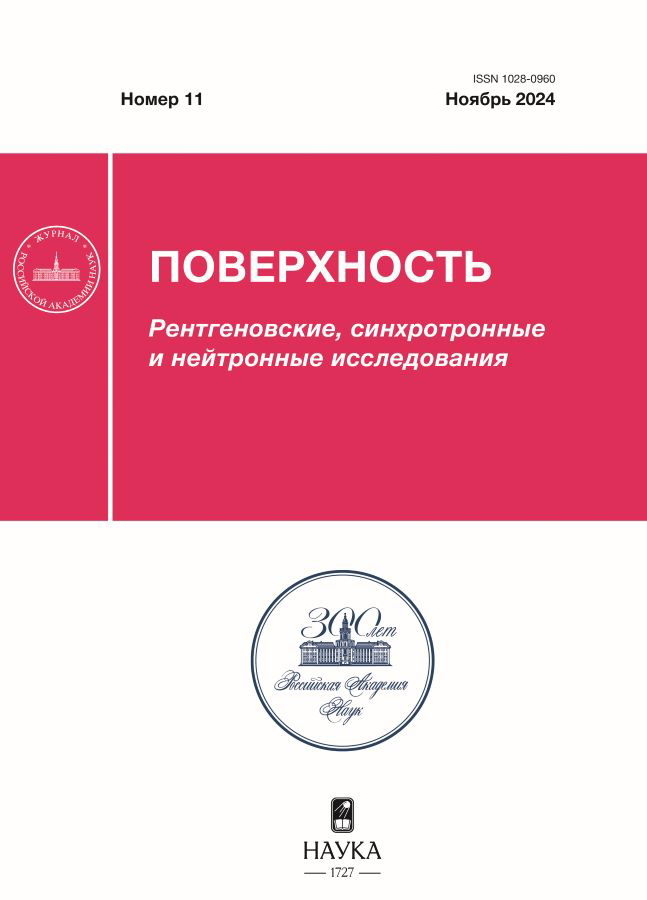Migration of Chromium on the Silicon Oxide Surface under the Strong Electric Field
- Authors: Uvarov I.V.1, Mazaletsky L.A.1
-
Affiliations:
- Yaroslavl Branch of the Valiev Institute of Physics and Technology of the RAS
- Issue: No 11 (2024)
- Pages: 4-11
- Section: Articles
- URL: https://ruspoj.com/1028-0960/article/view/681219
- DOI: https://doi.org/10.31857/S1028096024110012
- EDN: https://elibrary.ru/REXKJQ
- ID: 681219
Cite item
Abstract
Migration of chromium, which acts as an adhesive material for planar electrodes of a MEMS switch, over the surface of a thermally oxidized silicon wafer is demonstrated. Voltage pulses lead to the formation of chromium and carbon nanostructures on the driving electrode and their growth towards the signal electrode. Over time, the structures reach micron sizes and cover the interelectrode gap. Migration is activated by an electric field of about 108 V/m. The first structures appear after applying 102–105 pulses, but the process accelerates as they grow. For platinum electrodes, migration is faster and requires lower voltage compared to gold electrodes. Material transfer occurs not only in the gap between the electrodes, but also on the SiO2 surface around the positive electrode. The material also moves under the Pt and Au films, peeling them off from the substrate. The described phenomena can damage electrostatically actuated MEMS switches and other devices that use high electric fields.
Keywords
Full Text
About the authors
I. V. Uvarov
Yaroslavl Branch of the Valiev Institute of Physics and Technology of the RAS
Author for correspondence.
Email: i.v.uvarov@bk.ru
Russian Federation, Yaroslavl, 150067
L. A. Mazaletsky
Yaroslavl Branch of the Valiev Institute of Physics and Technology of the RAS
Email: i.v.uvarov@bk.ru
Russian Federation, Yaroslavl, 150067
References
- Rebeiz G.M. RF MEMS: Theory, Design, and Technology. Hoboken, New Jersey: John Wiley & Sons, Inc., 2003. 512 p.
- Cao T., Hu T., Zhao Y. // Micromachines. 2020. V. 11. Р. 694. doi: 10.3390/mi11070694
- Kurmendra, Kumar R. // Microsyst. Technol. 2021. V. 27. P. 2525. doi: 10.1007/s00542-020-05025-y
- Rebeiz G.M., Patel C.D., Han S.K., Ko C.-H., Ho K.M.J. // IEEE Microw. Mag. 2013. V. 14. P. 57. doi: 10.1109/MMM.2012.2226540
- Patel C.D., Rebeiz G.M. // IEEE Trans. Microw. Theory Techn. 2011. V. 59. P. 1230. doi: 10.1109/TMTT.2010.2097693
- Klein N., Gafni H. // IEEE Trans. Electron Dev. 1966. V. ED-13. P. 281. doi: 10.1109/T-ED.1966.15681
- Sze S.M. // J. Appl. Phys. 1967. V. 38. P. 2951. doi: 10.1063/1.1710030
- He M., Lu T.-M. Metal-Dielectric Interfaces in Gigascale Electronics. New York, NY: Springer Science+Business Media, LLC, 2012. 149 p.
- Uvarov I.V., Kupriyanov A.N. // Russ. Microelectron. 2018. V. 47. P. 307. doi: 10.1134/S1063739718050086
- Uvarov I.V. // Microelectron. Reliab. 2021. V. 125. Р. 114372. doi: 10.1016/j.microrel.2021.114372
- Lide D.R. CRC Handbook of Chemistry and Physics. Boca Raton: CRC Press/Taylor and Francis, 2009. 2760 p.
- Groudeva-Zotova S., Vitchev R.G., Blanpain B. // Surf. Interface Anal. 2000. V. 30. P. 544. doi: 10.1002/1096-9918(200008)30:1<544::AID-SIA814>3.0.CO;2-7
- Marechal N., Quesnel E., Pauleau Y. // J. Mater. Res. 1994. V. 9. P. 1820. doi: 10.1557/JMR.1994.1820
- McBrayer J.D., Swanson R.M., Sigmon T.W. // J. Electrochem. Soc. 1986. V. 133. P. 1242. doi: 10.1149/1.2108827
- Valov I., Waser R., Jameson J.R., Kozicki M.N. // Nanotechnology. 2011. V. 22. Р. 254003. doi: 10.1088/0957-4484/22/25/254003
- Tappertzhofen S., Mundelein H., Valov I., Waser R. // Nanoscale. 2012. V. 4. P. 3040. doi: 10.1039/C2NR30413A
- Tappertzhofen S., Menzel S., Valov I., Waser R. // Appl. Phys. Lett. 2011. V. 99. Р. 203103. doi: 10.1063/1.3662013
- Thermadam S.P., Bhagat S.K., Alford T.L., Sakaguchi Y., Kozicki M.N., Mitkova M. // Thin Solid Films. 2010. V. 518. P. 3293. doi: 10.1016/j.tsf.2009.09.021
- Yao J., Zhong L., Zhang Z., He T., Jin Z., Wheeler P.J., Natelson D., Tour J.M. // Small. 2009. V. 5. P. 2910. doi: 10.1002/smll.200901100
- Uvarov I.V., Kupriyanov A.N. // Microsyst. Technol. 2019. V. 25. P. 3243. doi: 10.1007/s00542-018-4188-4
- Jiang N., Silcox J. // J. Appl. Phys. 2000. V. 87. P. 3768. doi: 10.1063/1.372412
- Zhang X., Adelegan O.J., Yamaner F.Y., Oralkan O. // J. Microelectromech. Syst. 2018. V. 27. P. 190. doi: 10.1109/JMEMS.2017.2781255
- Shekhar S., Vinoy K.J., Ananthasuresh G.K. // J. Micromech. Microeng. 2018. V. 28. Р. 075012. doi: 10.1088/1361-6439/aaba3e
- Liu Y., Bey Y., Liu X. // IEEE Trans. Microw. Theory Techn. 2016. V. 64. P. 3151. doi: 10.1109/TMTT.2016.2598170
- Song Y.-H., Kim M.-W., Lee J.O., Ko S.D., Yoon J.B. // J. Microelectromech. Syst. 2013. V. 22. P. 846. doi: 10.1109/JMEMS.2013.2248125
- Song Y.-H., Han C.-H., Kim M.-W., Lee J.O., Yoon J.-B. // J. Microelectromech. Syst. 2012. V. 21. P. 1209. doi: 10.1109/JMEMS.2012.2198046
Supplementary files
















